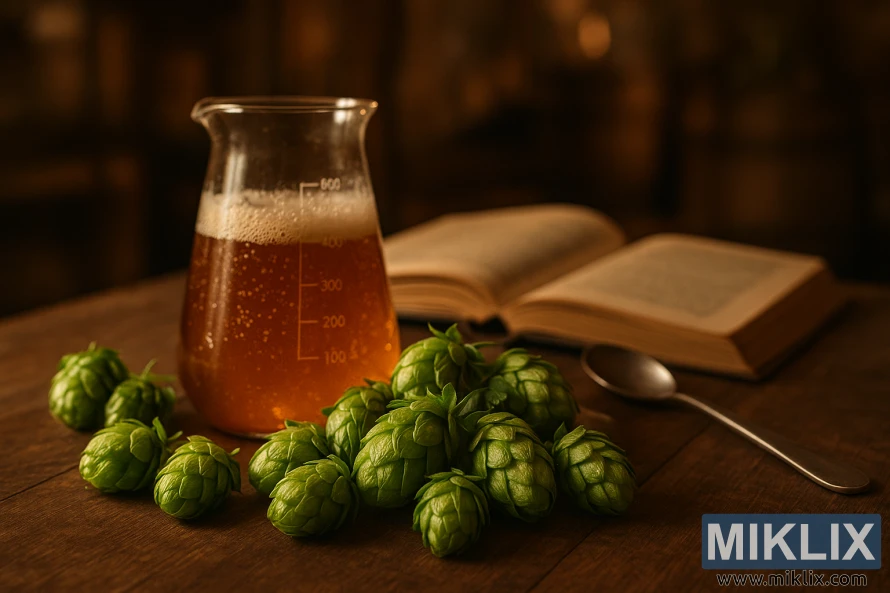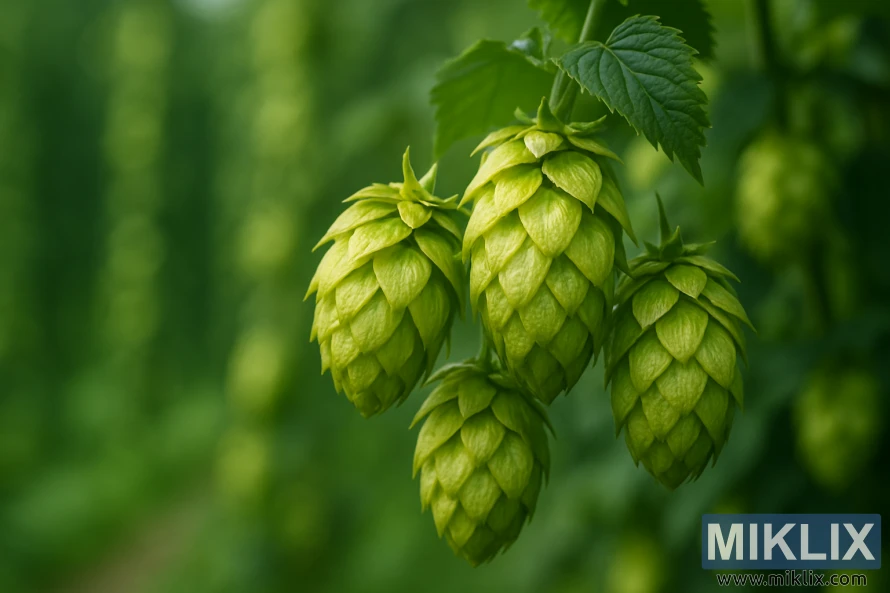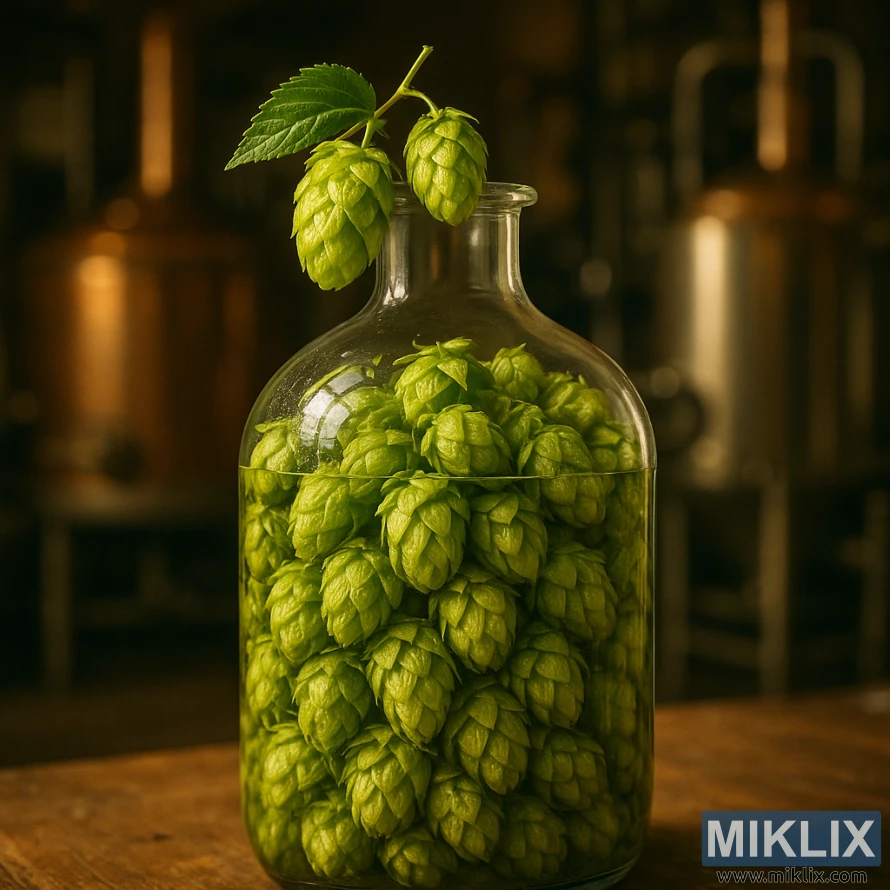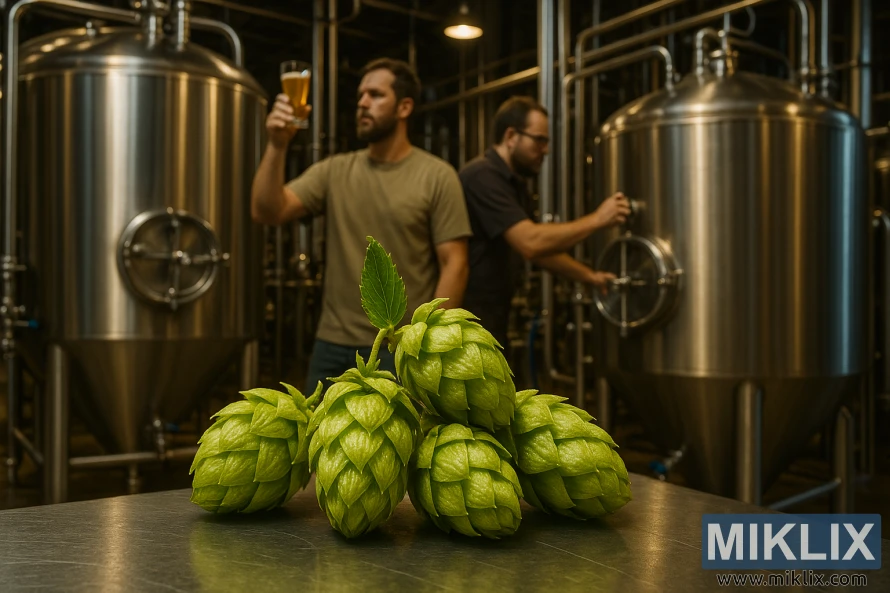Hops in Beer Brewing: Aquila
Published: August 29, 2025 at 8:05:03 AM UTC
Beer brewing is an art that requires a deep understanding of various ingredients, including hop varieties. Among these, Aquila Hops have gained recognition for their unique characteristics and brewing applications. Aquila Hops, developed in the Pacific Northwest and released in 1994, offer a distinct flavor and aroma profile. Their moderate alpha acid content and specific oil composition make them suitable for various beer styles. This enhances the brewing process.

Key Takeaways
- Aquila Hops are available from multiple suppliers.
- They were developed in the Pacific Northwest and released in 1994.
- Aquila Hops have a unique flavor and aroma profile.
- Their moderate alpha acid content is beneficial for brewing.
- They are suitable for various beer styles.
Introduction to Aquila Hops
Released in 1994, Aquila hops were the culmination of years of research and testing in the U.S. They were part of extensive commercial trials in the Northwest, starting in 1988. This marked a significant milestone in hop development.
Aquila hops have a rich brewing history. They were cultivated to meet the evolving needs of the beer brewing industry. Their development showcases advancements in hop cultivation and the quest for unique flavor profiles.
The establishment of Aquila hops in commercial trials underscored their great promise. It highlighted the capabilities of U.S. hop development. It also contributed to the diversity of hops available to brewers.
Understanding the background of Aquila hops is essential for appreciating their characteristics and applications in beer brewing. Their history and development are key to defining their use in various beer styles.
Chemical Composition and Properties
Aquila hops have a unique chemical profile, with specific alpha and beta acid percentages and oil composition. This profile is key for brewers, shaping the beer's flavor, aroma, and character.
The alpha acid content in Aquila hops averages around 7.7%, with beta acids at about 4%. This balance affects the hop's bittering and stability over time. Alpha acids, mainly humulone, adhumulone, and cohumulone, are behind the beer's bitterness. Beta acids, mainly lupulone, enhance the flavor and aroma.
The total oil composition of Aquila hops is also critical. It includes myrcene, humulene, and caryophyllene, which define the hop's aroma. Myrcene adds a piney and herbal note, while humulene and caryophyllene add complexity to the aroma.
The oil composition can vary due to growing conditions and harvesting practices. Yet, Aquila hops are known for their balanced oil profile. This makes them versatile for various brewing needs.
- Alpha acid content: 7.7% on average
- Beta acid content: 4%
- Total oil composition: Includes myrcene, humulene, and caryophyllene
Knowing the chemical composition and properties of Aquila hops helps brewers make better choices. Their distinct profile is ideal for a variety of brewing uses, from bittering to aroma additions.
Aroma and Flavor Profile of Aquila Hops
The sensory experience of Aquila hops is marked by a complex balance of aroma and flavor. Known for their moderate alpha acid content, they contribute to a balanced bitterness. This unique flavor profile can enhance various beer styles.
The aroma of Aquila hops is diverse, featuring notes from resinous and citrusy to woody and spicy. This variety stems from the hops' specific composition and the brewing process.
The flavor profile of Aquila hops is equally complex, making them a versatile ingredient for brewers. Key flavor notes include citrus and floral, adding a bright, refreshing quality. Resinous and piney flavors contribute to a crisp, bitter taste. Woody and spicy undertones enhance the beer's depth and complexity.
- Citrus and floral notes that add a bright, refreshing quality to beers
- Resinous and piney flavors that contribute to a crisp, bitter taste
- Woody and spicy undertones that enhance the depth and complexity of the beer
When used in brewing, Aquila hops add layers of complexity to the beer's flavor and aroma. Their moderate alpha acid content ensures balanced bitterness. Their unique flavor and aroma notes provide a rich sensory experience for the drinker.
In summary, the aroma and flavor profile of Aquila hops make them a valuable ingredient in beer brewing. Their complex balance of aroma and flavor notes, combined with their moderate alpha acid content, offer brewers a versatile tool for crafting a wide range of beer styles.

Alpha and Beta Acid Content
For brewers, grasping the alpha and beta acid content of Aquila hops is key. Alpha acids are the backbone of beer bitterness. Beta acids, on the other hand, shape the hop's aroma and flavor.
Aquila hops boast an alpha acid range of 6.5% to 8.9%. Beta acids fall between 3.0% and 4.9%. These figures are vital for brewers aiming to fine-tune their beer's bittering and flavor.
The alpha to beta acid ratio in Aquila hops makes them ideal for a wide range of beers. This knowledge empowers brewers to strategically use Aquila hops in their brews. Whether for bittering, flavor, or aroma, Aquila hops can enhance any beer style.
In the brewing art, the alpha and beta acid content of hops like Aquila is fundamental. By mastering these values, brewers can refine their beers' bitterness, flavor, and aroma. This leads to a more consistent and superior product.
- Alpha acid content: 6.5-8.9%
- Beta acid content: 3.0-4.9%
- Versatile for various brewing applications
Best Beer Styles for Aquila Hops
Aquila hops bring a unique edge to various beer styles. Their distinct traits enable brewers to explore different brewing techniques. This results in beers that truly stand out.
They are a perfect fit for American Ale and Farmhouse Ale. In American Ale, Aquila hops balance bitterness and flavor, enriching the beer's character. For Farmhouse Ale, they introduce a subtle complexity, complementing the style's traditional fruitiness and spiciness.
Aquila hops also excel in other styles where a balanced hop profile is sought. Brewers have successfully used them in Pale Ales and IPAs. This showcases their bittering and flavor capabilities, crafting complex, hop-forward beers.
When using Aquila hops in different styles, brewers must consider their alpha and beta acid content. They should also think about the aroma and flavor these hops add. This ensures the final product has the right balance and character.
- American Ale: Balanced bitterness and flavor
- Farmhouse Ale: Subtle complexity and traditional fruitiness
- Pale Ale/IPA: Complex, hoppy flavor profile
In conclusion, Aquila hops are a versatile ingredient for brewers. By understanding their characteristics and how they enhance different styles, brewers can craft unique, flavorful beers. These beers will appeal to a broad range of palates.
Harvesting and Processing Methods
Harvesting and processing Aquila hops requires careful steps to preserve their brewing quality. The timing of harvest is key, affecting the hops' quality and characteristics.
Aquila hops, part of commercial trials, had specific harvesting needs to meet quality standards. The process involves cutting the hop cones at the optimal time. This is when the cones are mature and alpha acids peak.
Post-harvest, processing methods are critical in keeping hop quality. Drying the cones removes excess moisture. This step prevents spoilage and keeps alpha acids and essential oils intact.
- Drying: Reduces moisture content to prevent spoilage.
- Baling: Compresses the dried hops into compact bales for storage and transportation.
- Packaging: Stores the hops in a cool, dry environment to maintain quality.
Through these methods, brewers can ensure Aquila hops retain their unique traits. This ensures they contribute to the desired flavor and aroma in beers.

Storage and Preservation Techniques
Proper storage and preservation of Aquila hops are key to maintaining their brewing quality. The Hop Storage Index (HSI) for Aquila hops shows a loss of alpha and beta acids over time. This loss can impact the brewing value significantly.
To reduce the loss of these valuable compounds, brewers should follow best practices. This includes storing hops in a cool, dry place, away from light and oxygen.
- Store hops in airtight containers or packaging that prevents exposure to air.
- Keep hops away from direct sunlight and heat sources.
- Maintain a consistent refrigerated temperature to slow down degradation.
By adopting these storage and preservation techniques, brewers can preserve the unique characteristics of Aquila hops. Effective preservation methods are vital. They ensure the hops retain their aroma, flavor, and bittering properties.
Regularly monitoring the condition and quality of stored hops is also important. This involves checking for visible signs of degradation and assessing hop quality through sensory evaluation or laboratory analysis.
Brewing Techniques with Aquila Hops
To fully benefit from Aquila hops, brewers need to grasp several essential techniques. These include late boil additions and dry hopping. Aquila hops are celebrated for their distinct flavor and aroma. By employing the right brewing methods, brewers can bring out the best in Aquila hops. This allows for the creation of a diverse array of beer styles.
Late boil additions are a key method for using Aquila hops. This technique involves adding hops towards the end of the boil, usually in the last 10-15 minutes. It helps preserve the delicate flavors and aromas of Aquila hops, leading to a more complex beer. For instance, adding Aquila hops in the last 5 minutes can enhance their citrus and floral notes.
Dry hopping is another vital technique for highlighting Aquila hops' qualities. It involves adding hops to the beer post-fermentation. This allows the hops to infuse the beer with their flavor and aroma without bitterness. Aquila hops, with their high alpha acid content and unique aroma, are ideal for dry hopping. This method results in beers with a pronounced hop character and a refreshing finish.
Beyond late boil additions and dry hopping, brewers can explore other techniques to showcase Aquila hops' versatility. These include:
- Hop bursting: Adding large quantities of hops in the last few minutes of the boil to create an intense hop flavor and aroma.
- First wort hopping: Adding hops to the wort before boiling to enhance the beer's bitterness and complexity.
- Hop blending: Combining Aquila hops with other hop varieties to create a unique and complex hop profile.
By mastering these techniques and experimenting with different hop applications, brewers can fully exploit Aquila hops. This leads to a wide range of beer styles that highlight their unique characteristics. Whether used in late boil additions, dry hopping, or other methods, Aquila hops provide brewers with a versatile ingredient for crafting exceptional beers.
Dry Hopping Applications
In the world of beer brewing, dry hopping with Aquila hops is celebrated for its ability to enhance the sensory experience. This technique involves adding hops to the beer after fermentation. It allows brewers to tap into the unique aromatic and flavor properties of Aquila hops, without adding bitterness.
Dry hopping with Aquila hops significantly boosts the aroma and flavor of beer, making it a favorite among craft brewers. The process involves adding hops to the beer tank or container. This allows the beer to absorb the hop's aromatic and flavor compounds.
- Enhanced aroma profile with floral and fruity notes
- Complex flavor profile with subtle spicy and herbal hints
- Ability to create unique and distinctive beer styles
To maximize the effectiveness of dry hopping with Aquila hops, brewers must consider several factors. These include the quantity of hops used, the duration of dry hopping, and the temperature during this process.
By carefully controlling these variables, brewers can create a balanced and complex beer profile. This showcases the unique characteristics of Aquila hops. Whether brewing a pale ale, IPA, or another hop-forward beer style, dry hopping with Aquila hops is a valuable technique.

Bittering Potentia and IBU Contribution
The alpha acid content in Aquila hops significantly impacts their bittering power and IBU contribution. Alpha acids are the key to beer's bitterness, directly affecting the International Bitterness Unit (IBU) of the final brew.
Aquila hops offer a unique bittering profile, essential for achieving the perfect flavor balance in beer. The bittering capacity of these hops is a critical factor. Brewers can adjust the bitterness by changing the amount of Aquila hops used during brewing.
To hit the desired IBU, brewers must consider the alpha acid content of the Aquila hops. They must calculate the hops needed during the boil to achieve the target bitterness. This ensures the beer's other flavors aren't overshadowed.
- The bittering power is directly tied to the alpha acid content.
- Brewers can tweak the IBU by adjusting the quantity of Aquila hops.
- The unique bitterness of Aquila hops can add depth to the beer's flavor.
By leveraging the bittering power of Aquila hops, brewers can craft beers with a balanced flavor. This appeals to a broad spectrum of consumers, making the brewing process both an art and a science.
Common Brewing Challenges and Solutions
Using Aquila hops in brewing can be challenging due to their high cohumulone content. Cohumulone, a part of alpha acids in hops, can make beer taste harsher. This is a major concern for brewers.
Managing the bitterness from Aquila hops and ensuring consistent brewing are key challenges. To tackle these, brewers can adjust hopping schedules or blend Aquila hops with others. This helps achieve a balanced flavor.
Understanding Aquila hops' properties is essential for troubleshooting. Brewers can use techniques like late hopping or dry hopping to reduce bitterness. These methods add complexity without increasing bitterness too much.
For brewers facing challenges with Aquila hops, experimenting with different techniques and hop combinations is key. Knowing how Aquila hops affect flavor and aroma helps brewers develop strategies to overcome challenges.
- Adjust hopping schedules to manage bitterness levels.
- Blend Aquila hops with other varieties for a balanced flavor.
- Employ late hopping or dry hopping techniques to add complexity.
By adopting these strategies, brewers can effectively use Aquila hops. They can create high-quality beers that highlight this hop variety's unique characteristics.
Commercial Brewing Applications
Exploring the role of Aquila hops in commercial brewing requires a look at their past and why they declined. Historical records show Aquila hops were once considered for commercial use but lost favor due to limited appeal.
Aquila hops' unique chemical makeup and properties define their commercial brewing applications. Though no longer common, their past use offers insights for brewers and the industry.
- Limited availability and high maintenance costs led to their decline in commercial brewing.
- Their distinct aroma and flavor, appealing to some, were inconsistent for large-scale production.
- Outdated brewing techniques and hop processing methods also hindered their adoption.
Looking at the challenges Aquila hops faced in commercial brewing teaches valuable lessons. Modern brewers can use these insights to enhance hop usage and brewing efficiency in industrial settings.
The tale of Aquila hops highlights the need for adaptability and innovation in commercial brewing. By learning from the past, brewers can better handle the complexities of hop usage and industrial applications.

Substitutes and Complementary Hop Varieties
For brewers looking for hop substitutes, Cluster and Galena are good options. These hops share characteristics with Aquila, making them suitable for recipes that require Aquila hops.
Aquila hops are celebrated for their distinct aroma and bittering capabilities. When substituting, brewers should aim for hops with similar alpha acid content and flavor profiles. Cluster hops, for example, have a balanced alpha acid content and a mild flavor. This makes them suitable for a wide range of beer styles.
Galena hops, with their high alpha acid content, are ideal for adding bitterness to beers. They also have a clean, neutral flavor that won't dominate other ingredients in the brew.
Other hop varieties can also complement Aquila's characteristics. Brewers might use these alternatives to craft unique flavor profiles or adjust recipes based on availability and desired outcomes.
- Cluster: Offers a balanced alpha acid content and mild flavor.
- Galena: Known for high alpha acid content and clean flavor.
- Other varieties: Can be used to create unique flavor profiles.
Quality Assessment Guidelines
Evaluating the quality of Aquila hops is essential for brewers aiming to meet brewing standards. The quality of hops greatly influences the beer's flavor, aroma, and overall character.
To assess the quality of Aquila hops, brewers should focus on several key aspects. These include:
- Alpha acid content: This determines the bittering power of the hops.
- Beta acid content: It adds to the beer's flavor and stability.
- Storage stability: This shows how well the hops maintain their quality over time.
The storage index is also critical, revealing the hop's ability to resist degradation during storage. By examining these factors, brewers can make informed choices about using Aquila hops for their brewing projects.
Quality assessment guidelines combine laboratory analysis and sensory evaluation. Laboratory tests measure alpha and beta acid content. Sensory evaluation, on the other hand, evaluates the hop's aroma and flavor.
By adhering to these guidelines, brewers can guarantee they are using top-quality Aquila hops that align with their brewing standards.
Sustainability and Environmental Impact
The brewing industry is evolving, and the environmental impact of hop production, like Aquila hops, is being closely examined. The sustainability of hop farming practices is essential for breweries looking to lessen their ecological footprint.
Responsible hop production encompasses several critical elements. These include water conservation, reduced pesticide use, and effective waste management. By embracing sustainable practices, hop farmers can significantly reduce their environmental impact.
- Implementing drip irrigation systems to reduce water waste
- Using integrated pest management techniques to minimize pesticide use
- Recycling and composting waste materials
By prioritizing sustainability, breweries can not only lessen their environmental impact but also contribute to a more responsible and eco-friendly supply chain. The adoption of sustainable hop production practices is a significant step towards achieving this goal.
Conclusion
Aquila hops have become a key player in the brewing world, known for their versatility and unique qualities. They cater to a wide range of beer styles, making them a valuable asset for brewers. Understanding Aquila hops, from their origins to their use in brewing, helps brewers harness their full flavor and aroma.
The future looks bright for Aquila hops, with ongoing advancements in brewing and shifting consumer tastes. As the industry evolves, the need for premium hops like Aquila will increase. This opens doors for brewers to create innovative recipes and explore new flavor combinations.
In summary, Aquila hops are set to be a major influence in the brewing industry's future. Their exploration is expected to drive growth and innovation, shaping the direction of beer brewing for years to come.
Further Reading
If you enjoyed this post, you may also like these suggestions:
